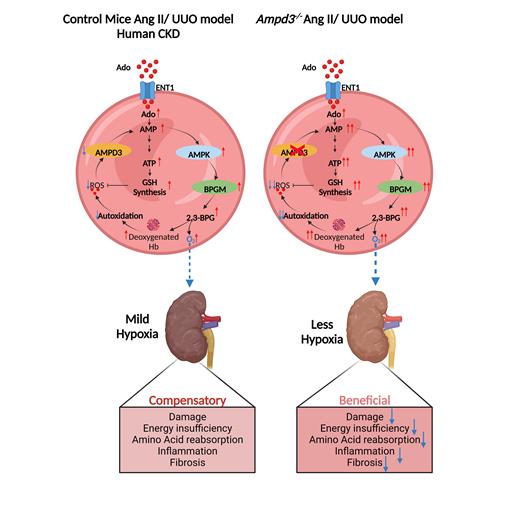Hypoxia is considered a common cause of myriad diseases and drives tissue damage and progression. Erythrocytes are vital under hypoxia since they can sense and act rapidly to hypoxia by promoting metabolomic reprogramming and oxygen (O 2) release. Adenosine monophosphate deaminase 3 (AMPD3) is highly enriched in erythrocytes and plays an important role in maintaining erythrocyte intracellular purine homeostasis. However, how it senses and regulates oxygen release remains poorly understood. Here we report that genetic ablation of AMPD3 led to more O 2 release from erythrocytes, resulting in less tissue hypoxia, damage, inflammation and fibrosis in two independent pathological hypoxia models including Angiotensin II infusion and unilateral ureteric obstruction (UUO) models. Metabolically, untargeted high-throughput metabolomic profiling in erythrocytes revealed that nucleotides including AMP, ADP and ATP levels were significantly increased in WT mice and further elevated in Ampd3 -/-mice. Isotopically adenosine flux experiment demonstrated that adenosine was rapidly and largely converted to AMP. At molecular level, we further demonstrated that hypoxia-induced AMPD3 activity as a compensatory mechanism led to accumulation of AMP, subsequently inducing AMP kinase (AMPK)-dependent metabolic reprogramming by inducing bisphosphoglycerate mutase (BPGM), which shifts glycolysis toward erythroid unique Rapoport-Leubering Shunt (RSL) to promote 2,3-BPG production, O 2 delivery and anti-ROS capacity to mitigate tissue hypoxia, dysfunction, inflammation and fibrosis. At cellular level, we revealed that hypoxia directly inhibited AMPD3, leading to activation of AMPK by lowering ROS in both cultured primary human and murine erythrocytes. Finally, we conducted human translational studies demonstrating that the production of 2,3-BPG, BPGM activity, p-AMPK level, and P50 were increased, while AMPD3 activity was decreased in patients with chronic kidney disease (a common pathological condition) compared with normal controls. Altogether, eAMPD3is a previously unrecognized master intracellular purinergic componentsensing hypoxia and promoting adaptative metabolic reprogramming tomitigate tissue hypoxia, insufficient energy, tissue damage and fibrosis by enhancing O 2 delivery and antioxidative stress capacity in a positive feedforward manner.
Disclosures
D'Alessandro:Hemanext Inc: Consultancy; Macopharma: Consultancy; Omix Technologies Inc: Current equity holder in private company.


This feature is available to Subscribers Only
Sign In or Create an Account Close Modal